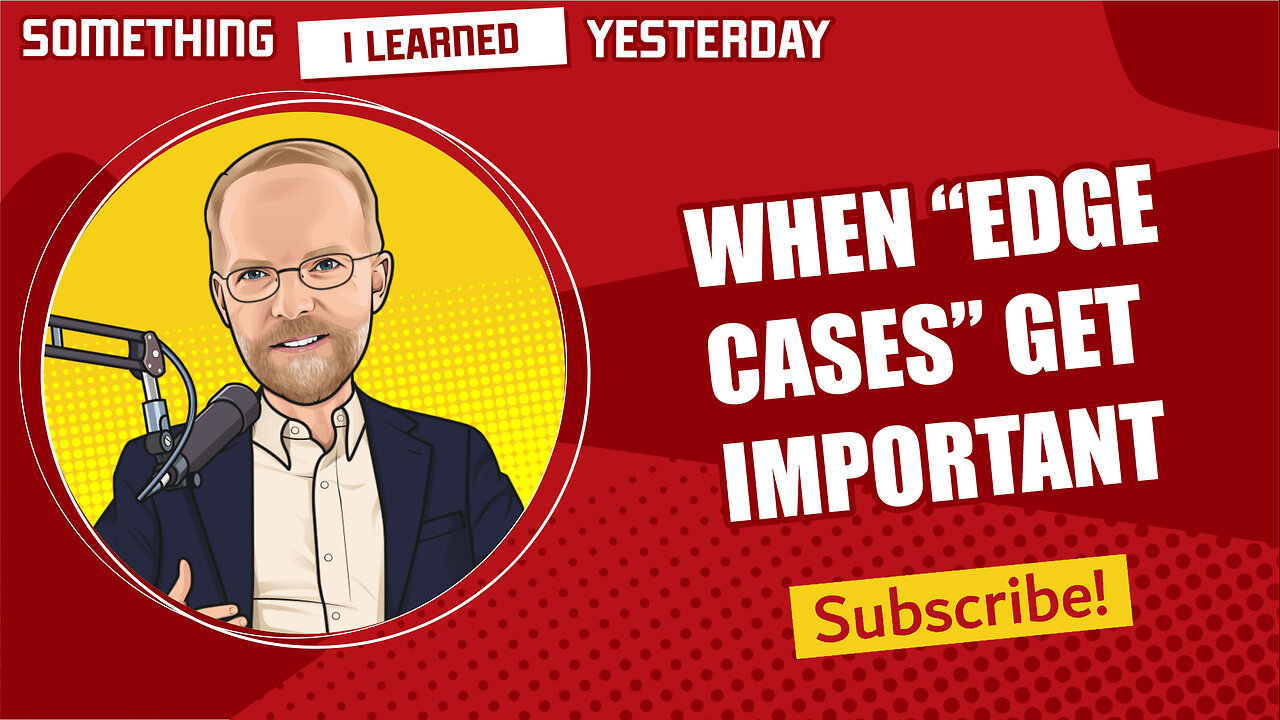Premium Only Content

154: Don't dismiss "edge cases" too easily
When someone says “that’s an edge case,” dig a little deeper.
As a general rule, marketers should major in the majors and pay attention to things that make a significant difference.
But sometimes an “edge case” can turn out to be more important than we realize.
Edge cases occur when …
* Someone behaves in a way you didn’t expect
* An action takes places in an environment you didn’t plan for
* A customer has untypical circumstances
* Two different systems collide
* There’s a change in regulations or technology
* A device is stressed, such as being low on memory
Edge cases are usually more of an issue for software and hardware developers than they are for marketers. Software has to work for every user, as much as possible. Marketers are dealing with audiences, and it’s understood that some people will fall through the cracks.
Today I’m going to highlight two situations. First, when “edge case” is used as an excuse, and second, then an edge case might be a missed opportunity.
Converting unknown to known in a CDP
A standard use case for a Customer Data Platform (CDP) is to convert unknown users to known. One way to do that is to append a customer ID as a query parameter to the links in your email. When the recipient clicks through, the CDP can capture that customer ID and convert a formerly unknown web profile to known.
But what if the recipient has forwarded the email, or has posted the link to social media? Whoever clicks on those links will now be identified as that customer ID, which will corrupt your data.
If your CDP tells you “this is an edge case,” what that really means is that they don’t have a good way to solve the problem. It’s not an edge case at all. People forward emails all the time.
You need to press your CDP for a better solution. Don’t accept “that’s an edge case” as an excuse.
Funnel analysis
The basic concept of a funnel is that if you get enough people at the top, and optimize each step in the funnel, you can get more people at the bottom – where they give you money. It’s a game of volume and percentages.
Let’s say some quirk (i.e., an “edge case”) in your system is causing you to lose 3 percent at the top of the funnel. That’s no big deal, right? You just adjust your inputs to compensate. Get a different 3 percent.
But what 3 percent are you losing? When you’re dealing with numbers and averages, you’re likely to assume the 3 percent you’re losing is a representative sample of the whole. A cross section. But that 3 percent might be your best customers.
For example, what if the quirk is cutting off people who use old iPhones, and that’s a characteristic of your target market. Say, “budget conscious consumers who are late technology adopters.”
A failure to investigate this “edge case” will affect your entire funnel.
Links
Why edge cases matter in marketing strategy
https://martech.org/why-edge-cases-matter-in-marketing-strategy/
-
 LIVE
LIVE
Dr Disrespect
3 hours ago🔴LIVE - DR DISRESPECT - MARVEL RIVALS - GOLD VANGUARD
5,069 watching -
 1:42:21
1:42:21
The Quartering
4 hours agoTrump To INVADE Mexico, Take Back Panama Canal Too! NYC Human Torch & Matt Gaetz Report Drops!
25.9K17 -

Nerdrotic
3 hours agoA Very Merry Christmas | FNT Square Up - Nerdrotic Nooner 453
14.7K3 -
 1:14:05
1:14:05
Tucker Carlson
3 hours ago“I’ll Win With or Without You,” Teamsters Union President Reveals Kamala Harris’s Famous Last Words
71K224 -
 1:58:31
1:58:31
The Dilley Show
3 hours agoTrump Conquering Western Hemisphere? w/Author Brenden Dilley 12/23/2024
59.7K9 -
 1:09:59
1:09:59
Geeks + Gamers
4 hours agoSonic 3 DESTROYS Mufasa And Disney, Naughty Dog Actress SLAMS Gamers Over Intergalactic
32.7K9 -
 51:59
51:59
The Dan Bongino Show
5 hours agoDemocrat Donor Admits The Scary Truth (Ep. 2393) - 12/23/2024
569K1.58K -
 2:32:15
2:32:15
Matt Kohrs
16 hours agoRumble CEO Chris Pavlovski Talks $775M Tether Partnership || The MK Show
90.7K27 -
 28:23
28:23
Dave Portnoy
16 hours agoDavey Day Trader Presented by Kraken - December 23, 2024
112K32 -
 59:29
59:29
BonginoReport
7 hours agoTrump, Murder Plots, and the Christmas Miracle: Evita + Jack Posobiec (Ep.110) - 12/23/2024
126K113